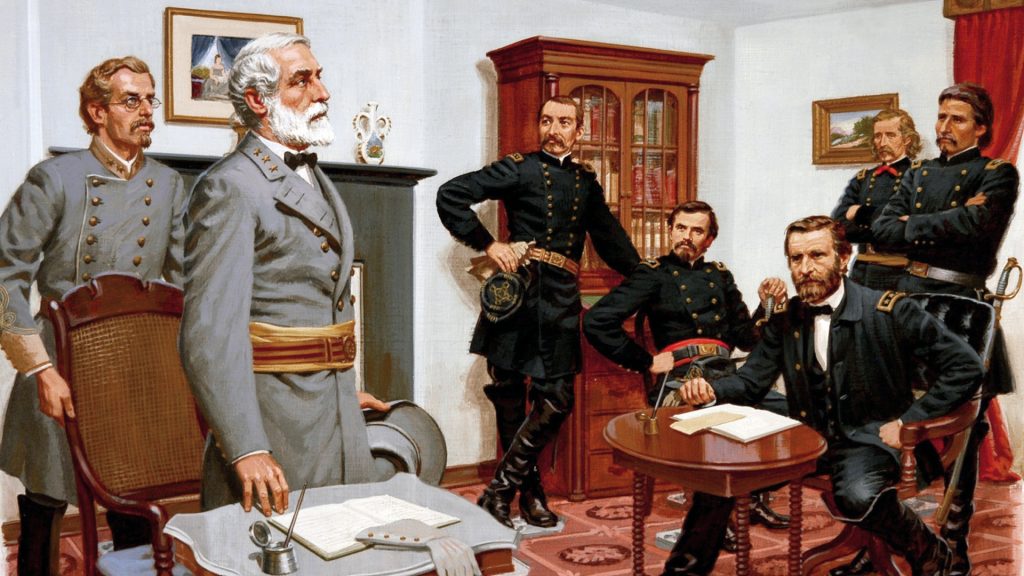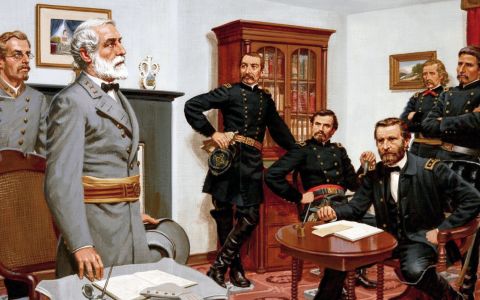
General Robert E. Lee surrendering his Army of Northern Virginia to Union Army General Ulysses S. Grant in Appomattox, Virginia, 1865. (Credit: Ed Vebell/Getty Images)
On April 9, 1865, General Robert E. Lee surrendered his Confederate troops to the Union’s Ulysses S. Grant at Appomattox Court House, Virginia, marking the beginning of the end of the grinding four-year-long American Civil War. But it would be more than 16 months before President Andrew Johnson would declare a formal end to the conflict in August 1866.
Appomattox was undoubtedly a decisive victory for the Union, and Grant’s peace agreement with Lee would provide a blueprint for other generals around the country. So why did it take so long for the war to officially end after that?

The Next to Fall
For one thing, Lee had surrendered only his Army of Northern Virginia to Grant. A number of other Confederate forces still remained active, starting with Gen. Joseph E. Johnston’s Army of Tennessee, the second-largest Confederate army after Lee’s
On April 12 in North Carolina, Johnston and his men received news of Lee’s surrender. The next day, Gen. William T. Sherman’s Union cavalry captured Raleigh, pushing Johnston’s forces westward. Under relentless pressure from Sherman, Johnston reached out to discuss peace terms. After the newly sworn-in President Johnson and his cabinet rejected an initial accord which gave generous political concessions to the South, Confederate President Jefferson Davis ordered Johnston to resume fighting. Johnston, knowing his back was to the wall, refused. On April 26, Sherman and Johnston signed a new surrender agreement, along the same lines as Grant and Lee’s Appomattox accord.
In the biggest surrender of the Civil War, Johnston gave up around 90,000 soldiers in all—virtually all remaining Confederate troops in the Carolinas, Georgia and Florida. When news of Johnston’s surrender reached Alabama, the next domino fell: Lt. Gen. Richard Taylor, the son of President Zachary Taylor and commander of some 10,000 Confederate men, concluded a similar peace with his Union counterpart in the region and surrendered his army on May 4.
Several days later, Nathan Bedford Forrest gave up his cavalry corps at Gainesville, Alabama, telling his men: “That we are beaten is a self-evident fact, and any further resistance on our part would justly be regarded as the very height of folly and rashness.”

West of the Mississippi
Still, the South wasn’t quite done. Even after those surrenders, after Union troops captured the fugitive Davis in Georgia and after President Johnson declared on May 10 that the South’s armed resistance “may be regarded as virtually at an end,” fighting still continued west of the Mississippi River.
Near Brownsville, Texas on May 12, a force of 350 Confederates under Col. John “Rip” Ford defeated 800 Union troops led by Col. Theodore H. Barrett in the Battle of Palmito Ranch, the last land battle of the Civil War. “It’s mainly Texans versus Texans,” says Charles D. Grear, professor of history at Central Texas College and author of Why Texans Fought in the Civil War. “It wasn’t really that big of a fight, but it’s still the last significant conflict of the Civil War.”
By that time, Lt. Gen. E. Kirby Smith’s Army of the Trans-Mississippi—the last major Confederate force still in the field—had begun disintegrating. “When the news arrives [about Appomattox], that’s when you’re going to have a mass exodus from the army,” Grear says, adding that by late May, Smith was “basically a general just in name, because he has no army.” On May 26, Smith surrendered his command at Galveston.
In Indian Territory (now Oklahoma), Brig. Gen. Stand Watie, the first Native American to serve as a Confederate general, kept his troops in the field for nearly a month after Smith gave up the Trans-Mississippi Army. On June 23, Watie finally acknowledged defeat and surrendered his unit of Confederate Cherokee, Creek, Seminole and Osage troops at Doaksville, near Fort Towson, becoming the last Confederate general to give up his command.
The CSS Shenandoah, a former British trade ship repurposed as a Confederate raider in 1864, continued terrorizing Union commercial ships in the Bering Sea long after the rebellion ended on land. Only in August 1865, when its skipper, Lt. Cmdr. James Waddell, got word that the war had definitively ended, did the ship stow its guns and make a covert escape to Liverpool, England, where it furled its giant Confederate flag for the last time.

Post-War Confusion in Texas
On April 2, 1866, President Johnson issued a proclamation stating that the insurrection was over in all of the former Confederate states but one: Texas, which had not yet succeeded in establishing a new state government.
Because the Texas economy, land and infrastructure had been impacted far less by the conflict than the rest of the South, many former Confederates from other states flocked there in the months after the conflict. “The Texas economy is prime, and it becomes this beacon for the rest of the South,” Grear explains. “People that are disgruntled throughout the South about their economic situation after the war—they’re going to be flooding into Texas.”
These waves of newly arrived white Southerners would clash head-on with another growing population in the state: former slaves. Texas’s black population had also exploded during the Civil War, since many Southern planters brought their slaves there to avoid them being captured by the Union Army. “Of course there’s going to be blowback against the emancipation of slaves,” Grear says. “You’re going to have violence toward freedmen throughout Texas.”
After President Johnson accepted Texas’ new constitution—which provided limited civil rights for blacks but refused to ratify the 13th Amendment, on the grounds that the abolition of slavery was already federal law—statewide elections were held in June. On August 9, the conservative Unionist James Webb Throckmorton was inaugurated as governor. (He would be removed from office the following year, due to his resistance to Reconstruction.)
On August 20, 1866, in acknowledgement of Texas’ new state government, Johnson was able to finally proclaim that “said insurrection is at an end and that peace, order, tranquility, and civil authority now exist in and throughout the whole United States of America.” His proclamation may have meant that the Civil War, by any definition, was finally over—but the arduous process of Reconstruction was only beginning.
For more, tune in to HISTORY Tues March 6 at 10/9c for the Series Premiere of The Curse of Civil War Gold.



